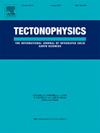死海断层是何时形成的?
IF 2.7
3区 地球科学
Q2 GEOCHEMISTRY & GEOPHYSICS
引用次数: 0
摘要
本研究重新评估了死海断裂系统(DSFS)20∼Myr的发展及其作为板块转换边界的构造定义。死海断裂系统传达了阿拉伯-西奈板块之间的正弦位移:沿其长达 400 公里的南段(亚喀巴湾-埃拉特到胡拉盆地)有 105 公里;沿中部和北部(各长 190 公里,横跨黎巴嫩、叙利亚西部和土耳其南部)有 90 公里和 4-16 公里。对以往研究的回顾,结合新的地震数据分析,将向北位移的下降与 DSFS 传播路径上的障碍联系起来。在中新世时期,DSFS 传播到西北走向的伊尔比德裂谷(第一道障碍),并向西北向地中海延伸,沿晚白垩世帕尔米拉褶皱推覆带向东北延伸(第二道障碍)。它的重新激活抬升了赫尔蒙和反黎巴嫩山脉。直到上新世早期(∼5 Ma),火山活动和持续的区域构造作用使得DSFS转移到Yammouneh断层,并在更北的Missyaf-Ghab分支断裂(分别为中部和北部地段)。在更新世晚期,DSFS 与蛇绿混杂岩带和东安纳托利亚断层系统(East Anatolian Fault System,EAFS)沿比特利斯缝合带(第 4 个障碍)的联系尚未确定。地震学数据显示,东安纳托利亚断裂带与东安纳托利亚断裂系统之间有明显的分隔,而地震活动则分散在阿勒颇高原以及东安纳托利亚断裂系统的中部和北部地段。相比之下,地震活动则集中在 DSFS 南部地段。我们的研究结果表明,目前,DSFS 仍未与 EAFS 在结构、地震学和构造上建立联系。因此,我们将 DSFS 重新定义为转型前,并认为其与 EAFS 的相互作用是正在形成的断层-断层-断层三重交界的世界级范例。本文章由计算机程序翻译,如有差异,请以英文原文为准。
When did the Dead Sea fault become a transform?
This study re-evaluates the ∼20 Myr development of the Dead Sea Fault System (DSFS) and its tectonic definition as a transform plate boundary. The DSFS conveys sinistral displacement between the Arabian-Sinai plates: ∼105 km along its ∼400 km-long southern segment (Gulf of Aqaba-Eilat to the Hula basin); ∼90 km and 4–16 km along the central and northern segments (∼190 km long each, across Lebanon, western Syria, and southern Turkey). A review of previous studies, combined with new seismological data analysis, associates the northward displacement decline with obstacles along the DSFS propagation path. During the Miocene, DSFS propagated up to the NW-trending Irbid rift (1st obstacle) and splayed NW towards the Mediterranean and NE along the Late Cretaceous Palmyra fold-thrust belt (2nd obstacle). Its reactivation uplifted the Hermon and the Anti-Lebanon mountain ranges. Northward DSFS propagation into the cold and rigid Aleppo plateau lithosphere (3rd obstacle) was stalled until the early Pliocene (∼5 Ma), when volcanism and ongoing regional tectonic forcing enabled the DSFS to shift to the Yammouneh fault and rupture through the Missyaf-Ghab branch farther north (central and northern segments, respectively). During the Pleistocene-recent, connection of the DSFS with the ophiolite belt and East Anatolian Fault System (EAFS) along the Bitlis suture zone (4th obstacle) has not yet been established. Seismological data show a clear separation between the EAFS and the DSFS, while seismicity is scattered across the Aleppo plateau and the central and northern DSFS segments. In contrast, seismicity is localized along the southern DSFS segment. Our findings suggest that, at present, the DSFS has still not made a structural, seismologic, and tectonic connection with the EAFS. Hence, we redefine the DSFS as a pre-transform and suggest its interaction with the EAFS is a world-class example of a fault-fault-fault triple junction in the making.
求助全文
通过发布文献求助,成功后即可免费获取论文全文。
去求助
来源期刊

Tectonophysics
地学-地球化学与地球物理
CiteScore
4.90
自引率
6.90%
发文量
300
审稿时长
6 months
期刊介绍:
The prime focus of Tectonophysics will be high-impact original research and reviews in the fields of kinematics, structure, composition, and dynamics of the solid arth at all scales. Tectonophysics particularly encourages submission of papers based on the integration of a multitude of geophysical, geological, geochemical, geodynamic, and geotectonic methods
 求助内容:
求助内容: 应助结果提醒方式:
应助结果提醒方式:


